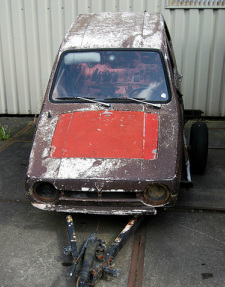
Everything is falling into place for her trip to Los Angeles. She has sublet a studio apartment in an ideal location for taking improv classes, and because getting around in L.A. is no snap, her Dad has offered her a not-so-pretty minivan.
She knows it’s petty, but that car does not fit the image she wants to project. It’s clunky and larger than a Scion or a Fit or a Mini-Cooper and bespeaks ordinary and safe whereas she wants to say cute, snappy, cutting edge. It’s a minivan, after all, a silver Ford Windstar of indeterminate age previously owned by a food bank in rural Northern California, and the roof is peeling.
First of all, I’m not faulting her for having this car image problem. It’s healthy to think she’s entitled to a positive view of herself. And if she follows my advice, no matter what car she drives in LA, she will see her bright side.
Yet it is important to acknowledge what marketing research has shown about the effect on one’s self-image of car and clothing brands. According to University of Minnesota researchers, one group of women was sent into a mall with a plain pink shopping bag and another group with a Victoria’s Secret bag. Those carrying the branded bag rated themselves more feminine, glamorous and good-looking.
Researchers also found that people who used a pen with the MIT logo rated themselves higher as leaders and smarter than others.
So it goes to show that brands have real power because, as researchers say, from the clothes we wear to the cars we drive and the bags we carry, they all make statements about who we are or who we want to be. And my point is that the stories we tell ourselves have that same power over us. They can enlighten or mislead, inspire or discourage.
The truth is, I, myself, drive an image-challenged car. It’s a maroon ’97 Toyota Corolla missing its hubcaps on the passenger side. In addition, the passenger side has numerous white scrapes, evidence that I have misjudged the parking space to which I have been assigned in my building’s garage. I can remember the loss of both hubcaps, how they bounced off when I brushed the curb on Noe Street.
When I look at the car, I see its unloveliness, its bruises, the unrepaired damage and I see a car not worth stealing, a car not needing to be heavily insured, a car that’s easy to pick out in a parking lot if you’re on the passenger side. To me, the car says I am not concerned with what people think of me or my materialism. Although I admit I have yet to hand over the keys for valet parking at any social gala.
Part of my comfort with driving an inconsequential car is reverse snobbism. I don’t live in Pacific Heights, Sea Cliff or Nob Hill, I live in eastern Western Addition, northern Hayes Valley, eastern Tenderloin and south Cathedral Hill, at an unglamorous address in this city of splendor.
Should anyone want to know why I drive that car, I have a story. Most queries, however, come from my parking lot friends at Safeway on Webster and O’Farrell, men who perceive me as having more money than they do, but notice that their cars look a lot better than mine. These are friends I don’t try to impress.
It’s when I am giving rides to more affluent friends that I explain the car’s declasse look as an example of urban detailing, as if the detailers offered me a special on denting, removal of original paint, scratching, scuffing, spills and stains.
Telling this story allows me to acknowledge the shamble the car is in but to project an aura of courage, conviction and competency, as if it’s a choice after all.
If Turquoise does drive the silver Windstar with the peeling roof around Los Angeles, my advice is to smile and improvise an incredible story behind this food bank cast off, something about the number of lives saved, skidding under falling branches, swerving through torrential downpours, skimming over frozen rutty back country roads, etc. Actually any story replete with detailing will do.
I have changed my niece’s name so as not to dent or tarnish her self-image.
 RSS Feed
RSS Feed